check engine YAMAHA GRIZZLY 350 2014 Owner's Manual
[x] Cancel search | Manufacturer: YAMAHA, Model Year: 2014, Model line: GRIZZLY 350, Model: YAMAHA GRIZZLY 350 2014Pages: 144, PDF Size: 3.34 MB
Page 105 of 144
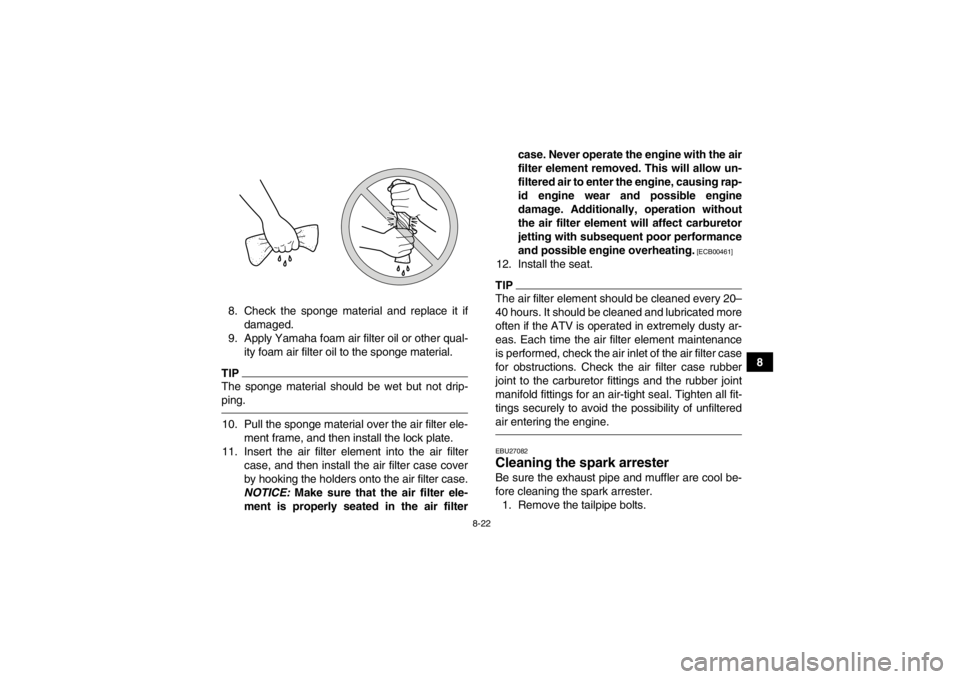
8-22
8
8. Check the sponge material and replace it if
damaged.
9. Apply Yamaha foam air filter oil or other qual- ity foam air filter oil to the sponge material.
TIPThe sponge material should be wet but not drip-
ping.10. Pull the sponge material over the air filter ele- ment frame, and then install the lock plate.
11. Insert the air filter element into the air filter case, and then install the air filter case cover
by hooking the holders onto the air filter case.
NOTICE: Make sure that the air filter ele-
ment is properly seated in the air filter case. Never operate the engine with the air
filter element removed. This will allow un-
filtered air to enter the engine, causing rap-
id engine wear and possible engine
damage. Additionally, operation without
the air filter element will affect carburetor
jetting with subsequent poor performance
and possible engine overheating.
[ECB00461]
12. Install the seat.TIPThe air filter element should be cleaned every 20–
40 hours. It should be cleaned and lubricated more
often if the ATV is operated in extremely dusty ar-
eas. Each time the air filter element maintenance
is performed, check the air inlet of the air filter case
for obstructions. Check the air filter case rubber
joint to the carburetor fittings and the rubber joint
manifold fittings for an air-tight seal. Tighten all fit-
tings securely to avoid the possibility of unfiltered
air entering the engine.EBU27082Cleaning the spark arrester Be sure the exhaust pipe and muffler are cool be-
fore cleaning the spark arrester.
1. Remove the tailpipe bolts.
U1NS62E0.book Page 22 Monday, April 8, 2013 4:59 PM
Page 107 of 144
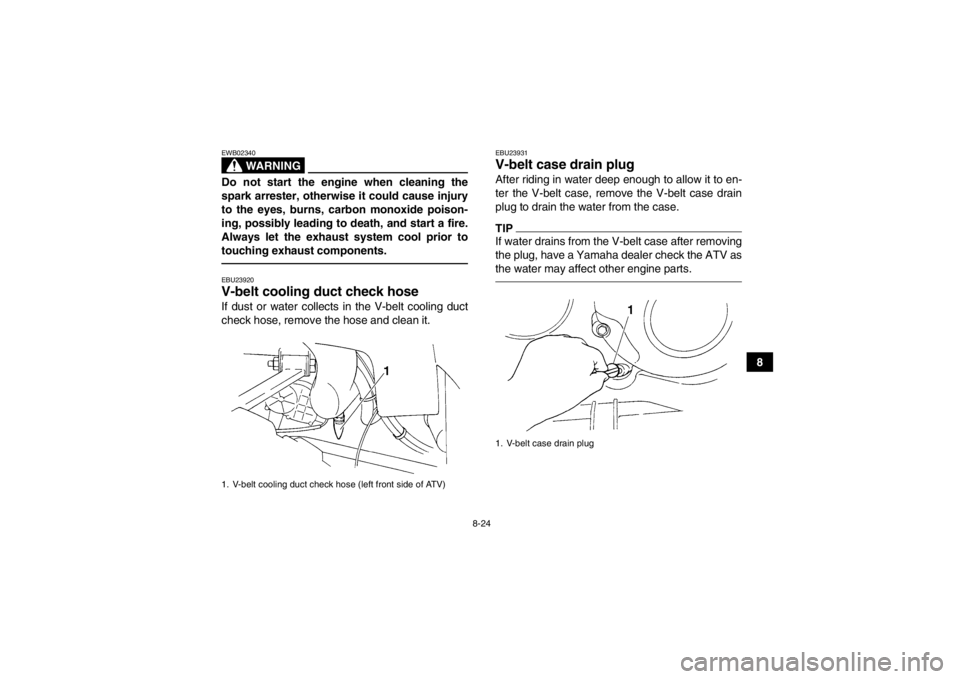
8-24
8
WARNING
EWB02340Do not start the engine when cleaning the
spark arrester, otherwise it could cause injury
to the eyes, burns, carbon monoxide poison-
ing, possibly leading to death, and start a fire.
Always let the exhaust system cool prior to
touching exhaust components.EBU23920V-belt cooling duct check hose If dust or water collects in the V-belt cooling duct
check hose, remove the hose and clean it.
EBU23931V-belt case drain plug After riding in water deep enough to allow it to en-
ter the V-belt case, remove the V-belt case drain
plug to drain the water from the case.TIPIf water drains from the V-belt case after removing
the plug, have a Yamaha dealer check the ATV as
the water may affect other engine parts.
1. V-belt cooling duct check hose (left front side of ATV)
1. V-belt case drain plug
U1NS62E0.book Page 24 Monday, April 8, 2013 4:59 PM
Page 108 of 144
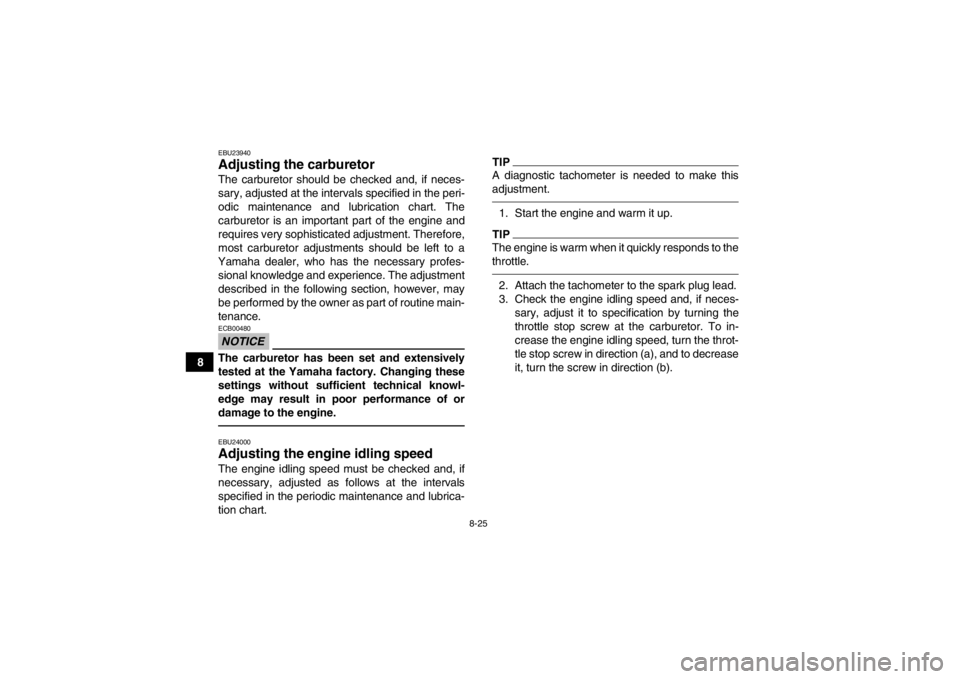
8-25
8
EBU23940Adjusting the carburetor The carburetor should be checked and, if neces-
sary, adjusted at the intervals specified in the peri-
odic maintenance and lubrication chart. The
carburetor is an important part of the engine and
requires very sophisticated adjustment. Therefore,
most carburetor adjustments should be left to a
Yamaha dealer, who has the necessary profes- sional knowledge and experience. The adjustment
described in the following section, however, may
be performed by the owner as part of routine main-
tenance.NOTICEECB00480The carburetor has been set and extensively
tested at the Yamaha factory. Changing these
settings without sufficient technical knowl-
edge may result in poor performance of or
damage to the engine.EBU24000Adjusting the engine idling speed The engine idling speed must be checked and, if
necessary, adjusted as follows at the intervals
specified in the periodic maintenance and lubrica-
tion chart.
TIPA diagnostic tachometer is needed to make this
adjustment.1. Start the engine and warm it up.TIPThe engine is warm when it quickly responds to the
throttle.2. Attach the tachometer to the spark plug lead.
3. Check the engine idling speed and, if neces- sary, adjust it to specification by turning the
throttle stop screw at the carburetor. To in-
crease the engine idling speed, turn the throt-
tle stop screw in direction (a), and to decrease
it, turn the screw in direction (b).
U1NS62E0.book Page 25 Monday, April 8, 2013 4:59 PM
Page 109 of 144
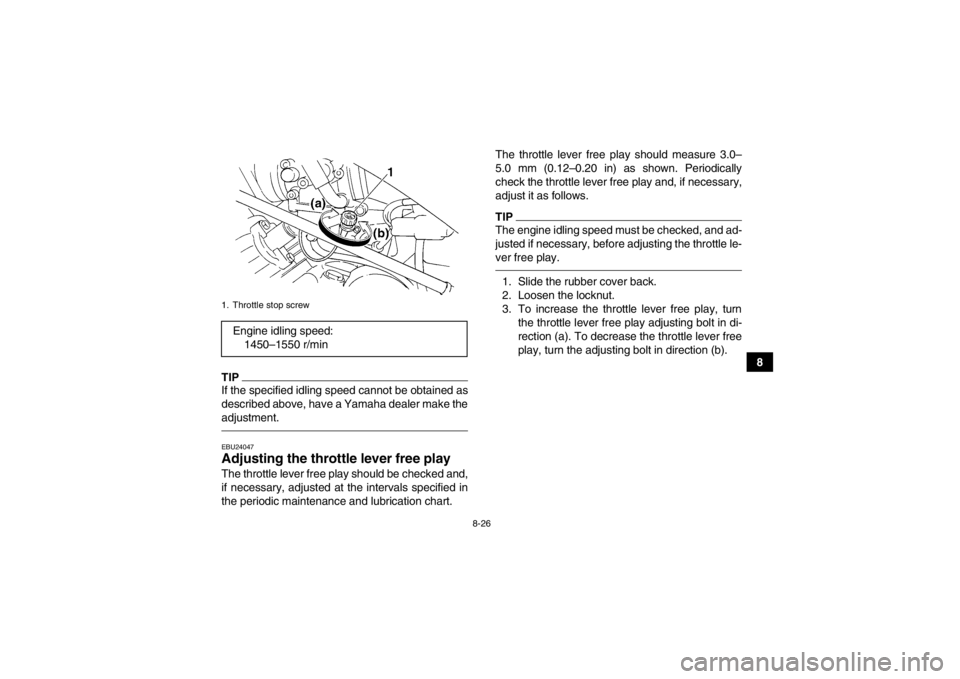
8-26
8
TIPIf the specified idling speed cannot be obtained as
described above, have a Yamaha dealer make the
adjustment.EBU24047Adjusting the throttle lever free play The throttle lever free play should be checked and,
if necessary, adjusted at the intervals specified in
the periodic maintenance and lubrication chart.The throttle lever free play should measure 3.0–
5.0 mm (0.12–0.20 in) as shown. Periodically
check the throttle lever free play and, if necessary,
adjust it as follows.
TIPThe engine idling speed must be checked, and ad-
justed if necessary, before adjusting the throttle le-
ver free play.1. Slide the rubber cover back.
2. Loosen the locknut.
3. To increase the throttle lever free play, turn
the throttle lever free play adjusting bolt in di-
rection (a). To decrease the throttle lever free
play, turn the adjusting bolt in direction (b).
1. Throttle stop screwEngine idling speed:1450–1550 r/min
U1NS62E0.book Page 26 Monday, April 8, 2013 4:59 PM
Page 110 of 144
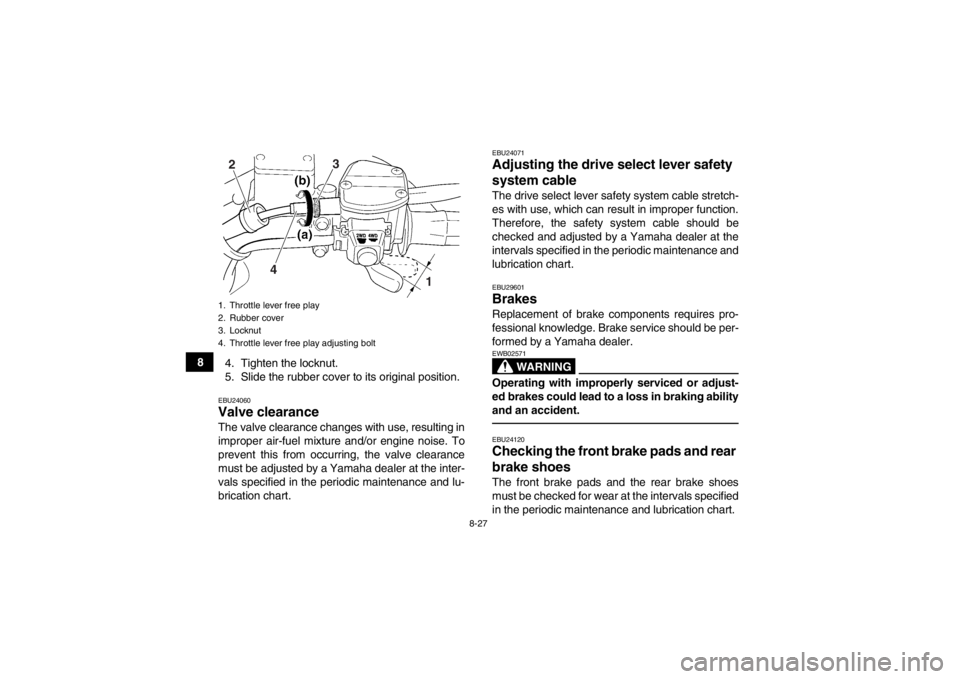
8-27
84. Tighten the locknut.
5. Slide the rubber cover to its original position.
EBU24060Valve clearance The valve clearance changes with use, resulting in
improper air-fuel mixture and/or engine noise. To
prevent this from occurring, the valve clearance
must be adjusted by a Yamaha dealer at the inter-
vals specified in the periodic maintenance and lu-
brication chart.
EBU24071Adjusting the drive select lever safety
system cable The drive select lever safety system cable stretch-
es with use, which can result in improper function.
Therefore, the safety system cable should be
checked and adjusted by a Yamaha dealer at the
intervals specified in the periodic maintenance and
lubrication chart.EBU29601Brakes Replacement of brake components requires pro-
fessional knowledge. Brake service should be per-
formed by a Yamaha dealer.
WARNING
EWB02571Operating with improperly serviced or adjust-
ed brakes could lead to a loss in braking ability
and an accident.EBU24120Checking the front brake pads and rear
brake shoes The front brake pads and the rear brake shoes
must be checked for wear at the intervals specified
in the periodic maintenance and lubrication chart.
1. Throttle lever free play
2. Rubber cover
3. Locknut
4. Throttle lever free play adjusting bolt2
4 3
1
U1NS62E0.book Page 27 Monday, April 8, 2013 4:59 PM
Page 131 of 144
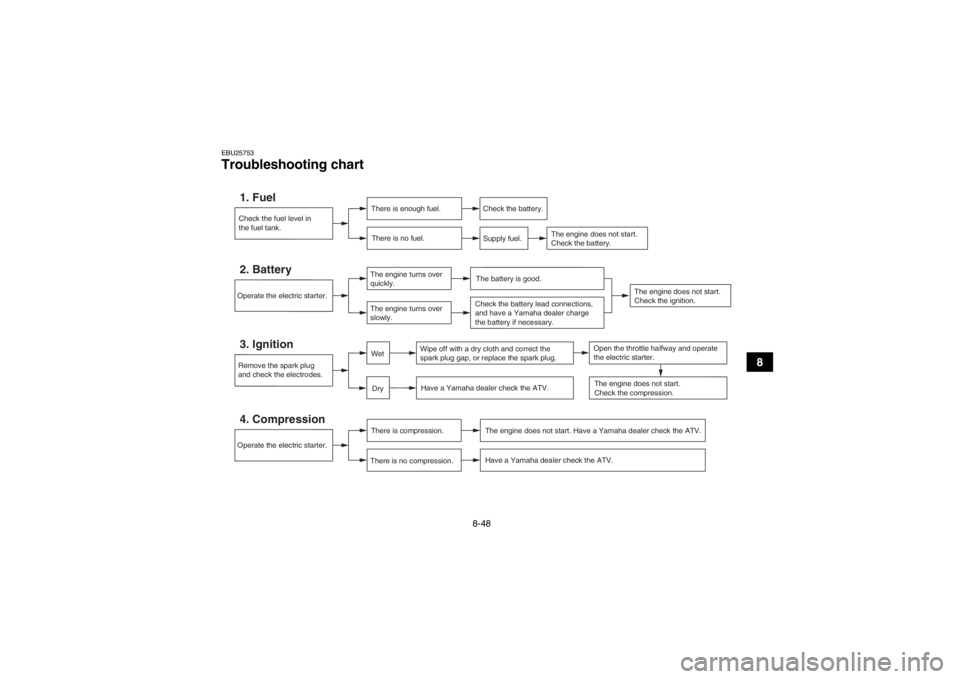
8-48
8
EBU25753Troubleshooting chart
Check the fuel level in
the fuel tank.1. Fuel
There is enough fuel.There is no fuel.
Check the battery.
Supply fuel.
The engine does not start.
Check the battery.
The engine does not start.
Check the ignition.
Operate the electric starter.4. Compression
There is compression.
There is no compression.
The engine does not start. Have a Yamaha dealer check the ATV.Have a Yamaha dealer check the ATV.
Remove the spark plug
and check the electrodes.3. Ignition
Wipe off with a dry cloth and correct the
spark plug gap, or replace the spark plug. Have a Yamaha dealer check the ATV.
The engine does not start.
Check the compression.
Operate the electric starter.2. Battery
The engine turns over
quickly.
The engine turns over
slowly.
The battery is good.Check the battery lead connections,
and have a Yamaha dealer charge
the battery if necessary.
DryWet
Open the throttle halfway and operate
the electric starter.
U1NS62E0.book Page 48 Monday, April 8, 2013 4:59 PM
Page 133 of 144

9-2
9
EBU25933Storage Short-term
Always store your ATV in a cool, dry place and, if
necessary, protect it against dust with a porous
cover. NOTICE: Storing the ATV in a poorly ven-
tilated room or covering it with a tarp while it is
still wet, will allow water and humidity to seep
in and cause rust. To prevent corrosion, avoid
damp cellars, stables (because of the presence
of ammonia) and areas where strong chemi-
cals are stored.
[ECB00721]
Long-term
Before storing your ATV for several months: 1. Follow all the instructions in the “Cleaning” section of this chapter.
2. Turn the fuel cock lever to “OFF”.
3. Drain the carburetor float chamber by loosen- ing the drain bolt; this will prevent fuel deposits
from building up. Pour the drained fuel into the
fuel tank.
4. Fill up the fuel tank and add fuel stabilizer (if available) to prevent the fuel from deteriorat-
ing. 5. Perform the following steps to protect the cyl-
inder, piston rings, etc. from corrosion.a. Remove the spark plug cap and spark plug.
b. Pour a teaspoonful of engine oil into the spark plug bore.
c. Install the spark plug cap onto the spark plug, and then place the spark plug on the
cylinder head so that the electrodes are
grounded. (This will limit sparking during
the next step.)
d. Turn the engine over several times with the starter. (This will coat the cylinder wall with
oil.)
e. Remove the spark plug cap from the spark plug, and then install the spark plug and
the spark plug cap.
6. Lubricate all control cables and the pivoting points of all levers and pedals.
7. Check and, if necessary, correct the tire air pressure, and then block up the ATV so that
all of its wheels are off the ground. Alternative-
Specified amount:
7.5 ml of stabilizer to each liter of fuel (or 1
oz of stabilizer to each gallon of fuel)U1NS62E0.book Page 2 Monday, April 8, 2013 4:59 PM
Page 142 of 144

INDEX
AAccessories and loading ................................................ 6-6
Air filter element, cleaning ............................................ 8-19
Axle boots .................................................................... 8-35BBattery .......................................................................... 8-39
Brake fluid, changing .................................................... 8-30
Brake fluid level, checking ............................................ 8-29
Brake lever free play, checking the front ...................... 8-30
Brake lever, front ............................................................ 4-8
Brake levers, checking and lubricating ......................... 8-37
Brake light switches ..................................................... 8-35
Brake pads and shoes, checking ................................. 8-27
Brake pedal and rear brake lever ................................... 4-8
Brake pedal, checking and lubricating ......................... 8-37
Brakes .......................................................................... 8-27
Brakes, front and rear .................................................... 5-3CCables, checking and lubricating ................................. 8-36
Carburetor, adjusting .................................................... 8-25
Carrier, front ................................................................. 4-16
Carrier, rear .................................................................. 4-16
Chassis fasteners ........................................................... 5-6
Cleaning ......................................................................... 9-1DDifferential gear oil ......................................................... 5-3
Differential gear oil, changing ....................................... 8-18
Drive select lever .......................................................... 4-10 Drive select lever and driving in reverse ........................ 6-3
Drive select lever safety system cable, adjusting ......... 8-27
EEngine break-in .............................................................. 6-4
Engine, cold start ........................................................... 6-1
Engine idling speed ...................................................... 8-25
Engine oil ....................................................................... 5-3
Engine oil and oil filter cartridge ................................... 8-11
Engine, starting a warm ................................................. 6-3
Engine stop switch ......................................................... 4-5FFinal gear oil .......................................................... 5-3, 8-15
Four-wheel-drive indicator light ...................................... 4-3
Fuel ....................................................................... 4-11, 5-3
Fuel cock ...................................................................... 4-12
Fuel tank cap ................................................................ 4-10
Fuses, replacing ........................................................... 8-41HHandlebar switches ........................................................ 4-5
Headlight beam, adjusting ............................................ 8-45
Headlight bulb, replacing .............................................. 8-43
Horn switch .................................................................... 4-5IIdentification numbers .................................................. 11-1
Indicator lights and warning light .................................... 4-2
Instruments, lights and switches .................................... 5-6LLabel locations ............................................................... 1-1
U1NS62E0.book Page 1 Monday, April 8, 2013 4:59 PM